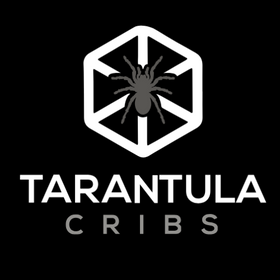Monocentropus Balfouri | Socotra Island Blue Baboon | Tarantula Care Guide
Common Name: Socotra Island Blue Baboon
Scientific Name: Monocentropus balfouri
Lifespan: 12-15 years (females), 3-5 years (males)
Size: 5-6 inches (leg span)
This species is admired for its striking blue and tan coloration and is suited for intermediate to advanced keepers due to its defensive nature and high speed. It’s a unique species, especially for those interested in communal setups, though care must be taken to monitor for signs of aggression in group housing.
Housing
- Enclosure Size: A 5-10 gallon tank for adults is sufficient. This species is terrestrial but will appreciate both horizontal and vertical space for burrowing and webbing. We would recommend any of the Terrestrial Enclosures we have in the shop.
- 0.5"-1": Terrestrial Sling Crib
- 1"-3": Small Slider or Small Cuboid
- Full size adult: Large Slider, Large Cuboid, or Large Coffin.
- If you wish to go a bit overboard, you can do the Terrestrial XL but for this species it is not needed at all.
- Substrate: 4-6 inches of a mix of coco fiber, peat moss, or topsoil. Monocentropus balfouri is a burrowing species, so deep substrate is essential for natural behaviors. We recommend the Arachnidirt in our shop.
- Hide: Provide hides like cork bark or half logs. They will create burrows or use the hide to build intricate webs around. We have a ton of great accessories.
- Ventilation: Ensure proper ventilation to prevent mold growth but maintain some humidity.
Temperature and Humidity
- Temperature: 75-85°F (24-29°C). Keep them within this temperature range, though they are fairly hardy and can tolerate a range of conditions.
- Humidity: 60-70%. Mist lightly every few days, but make sure the substrate doesn't get too damp. Proper ventilation will prevent mold.
- Water Dish: A shallow water dish should be available at all times.
Diet
- Food: Feed gut-loaded crickets, roaches, or mealworms. Adults can be fed once every 7-10 days, while juveniles should be fed every 5-7 days.
- Size of Prey: Prey should be smaller than the tarantula's abdomen.
- Feeding Notes: Monocentropus balfouri is an efficient hunter. Remove any uneaten prey within 24 hours.
Temperament/Personality
- Behavior: This species is known for being defensive but less aggressive compared to other Old World tarantulas. They are fast and may retreat to their burrows when disturbed.
- Handling: Handling is not recommended due to their speed, defensive nature, and potent venom. Bites can be painful, though not medically significant to humans.
Molting
- Signs of Molting: They will refuse food and become more reclusive before molting. Their behavior may also slow down as they prepare to molt.
- After Molting: Avoid feeding for about a week to ensure their new exoskeleton has hardened.
Cleaning and Maintenance
- Spot Clean: Remove uneaten prey and waste regularly. Monitor humidity to prevent mold.
- Full Cleaning: Replace substrate and clean the enclosure every 6-12 months, depending on the condition of the setup.
Social Behavior
- Communal Housing: One of the few tarantula species that can be kept communally under certain conditions. If attempting a communal setup, ensure plenty of space, hides, and food to prevent cannibalism.
General Notes
- Webbing and Burrowing: Monocentropus balfouri is known for both burrowing and heavy webbing. They may create tunnels and web structures around their burrow entrances.
- Lighting: No special lighting is required. Avoid direct sunlight and heat sources that could dry out the enclosure.
- Activity: Mostly nocturnal but active hunters. They are more likely to retreat into their burrows than stay in the open during the day.
Where to find this tarantula?
- Coming soon


